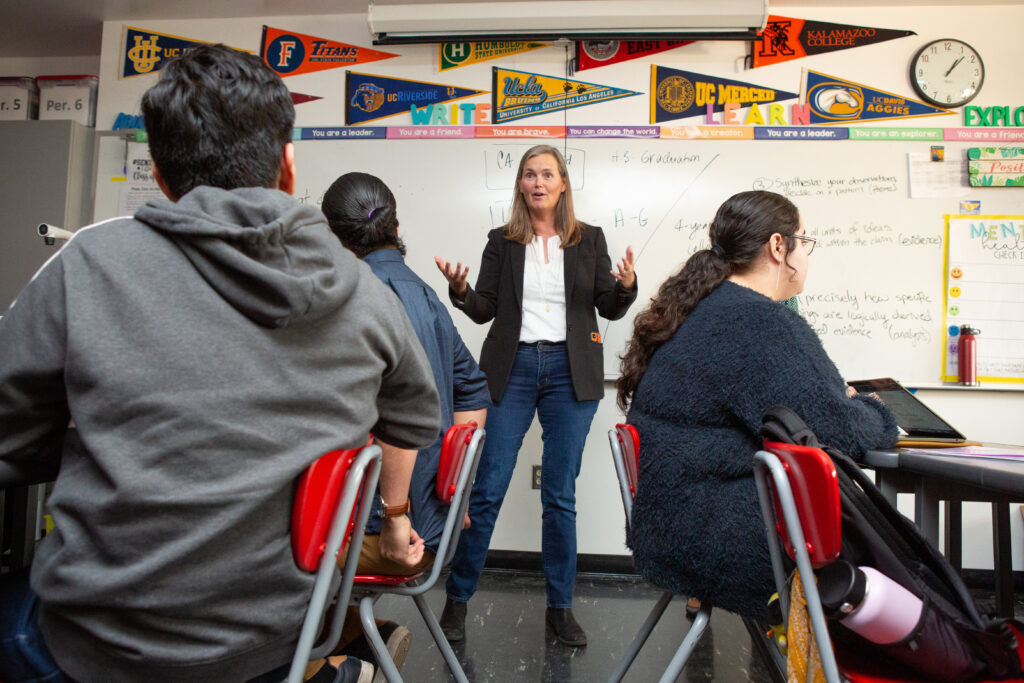
A teacher kicks off a lesson during an AP research class.
Credit: Allison Shelley / EDUimages
As a former teacher and principal, and a current school board member, I am intimately familiar with the impact of the teacher shortage and consider it one of California’s most pressing and intractable problems. To address this multifaceted issue, schools need a wide array of options, including Assembly Bill 1224, pending state legislation that would increase continuity of instruction when teachers are out on leave and when a school struggles to fill a teacher vacancy.
Authored by Assemblymember Avelino Valencia and co-sponsored by the California Schools Boards Association, the Association of California School Administrators, the California County Superintendents, and the California Association of School Business Officials, AB 1224 would allow substitute teachers to serve in a single classroom for up to 60 days, provided the school district or county office of education can demonstrate it made reasonable efforts to recruit a full-time teacher before retaining the substitute. Until every classroom has a qualified full-time teacher, let’s at least make sure every classroom has a consistent one.
When the Covid-19 pandemic exacerbated already dire teacher shortages, the state temporarily expanded the 30-day limit on substitute teaching to 60 days, a measure that was effective in responding to vacancies and extended absences. That statute expired in July 2024, but with upcoming Senate Education Committee amendments, AB 1224 would revive its provisions for another three years. Using the lessons learned from the successful trial run, the bill would extend the time a substitute can stay in a single assignment from 30 to 60 days in general education and from 20 to 60 days in special education.
In a perfect world, every classroom would have a fully certificated teacher on the first day of class, the last day of class and every day between. As a lifelong educator, I know the value of having a full-time teacher share their learning and wisdom with students on a consistent basis. But there simply aren’t enough full-time teachers to go around. So, we must make policy and governance decisions that reflect the current reality while simultaneously working to build a better system that sets substitutes and students up for success.
Local educational agencies rely on substitutes, but current law forbids a substitute teacher from serving in the same classroom for more than 30 consecutive days. In cases where a school district or county office of education cannot identify a full-time teacher, such as a mid-year departure or one that occurs before the start of the school year, this can lead to a revolving door of substitute teachers that disrupts instruction and destabilizes the classroom environment. These impacts are felt most acutely in low-income and rural schools, and the burden falls disproportionately on English learners, minority students and students from families of modest means. Without AB 1224, students already cycle through different substitutes every few weeks, so the real debate isn’t about lowering standards, it’s about increasing stability.
An insufficient pipeline of newly credentialed teachers and attrition from the profession means that the teacher shortage will persist. Thus, staffing schools — particularly in hard-to-fill areas like special education, math and science — will remain a daunting task. AB 1224 responds to that challenge by adding another tool to the toolbox that schools can use to fill gaps in their instructional workforce.
Critics of AB 1224 claim it would diminish the push to recruit credentialed educators. Real world evidence shows the opposite. Examples abound of LEAs raising salaries, implementing incentive pay, offering signing bonuses, expanding mentorship programs, deploying advertising campaigns, hosting virtual and in-person job fairs, building staff housing for educators, and developing internal pipelines through teacher academies or programs for classified staff who want to transition to the teaching profession. Additional guardrails to preserve the primacy of full-time teachers include collective bargaining agreements governing the hiring process and a bill provision requiring that schools document their efforts to recruit full-time teachers.
It’s disingenuous to suggest extending substitute assignments would undermine the search for long-term solutions to the teacher crisis. It’s also poor logic based on a false binary and an idealized labor market that doesn’t actually exist. This is not a choice between AB 1224 or full-time teacher recruitment; we can and must pursue both remedies. New federal and state programs targeting the teacher shortage are promising but take years, if not generations, to bear fruit when immediate relief is essential. Waiting for long-term pipelines to mature does nothing for students in classrooms today — AB 1224 provides the immediate help schools need to increase stability in the classroom.
•••
Bettye Lusk is president of the California School Boards Association. Lusk is a former teacher and principal in the Monterey Peninsula Unified School District, where she currently serves on the Board of Education.
The opinions expressed in this commentary represent those of the author. EdSource welcomes commentaries representing diverse points of view. If you would like to submit a commentary, please review our guidelines and contact us.

دیدگاهتان را بنویسید